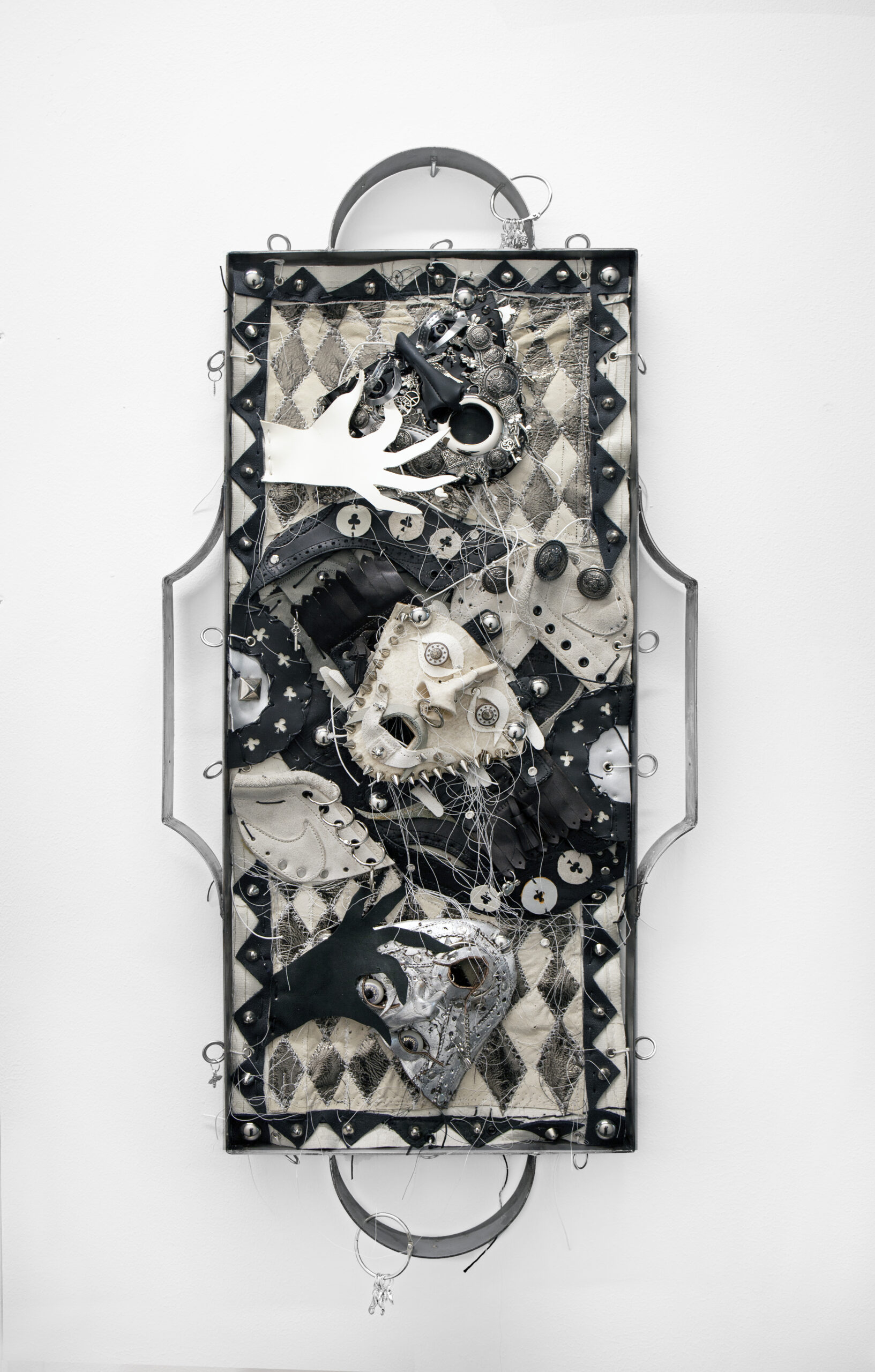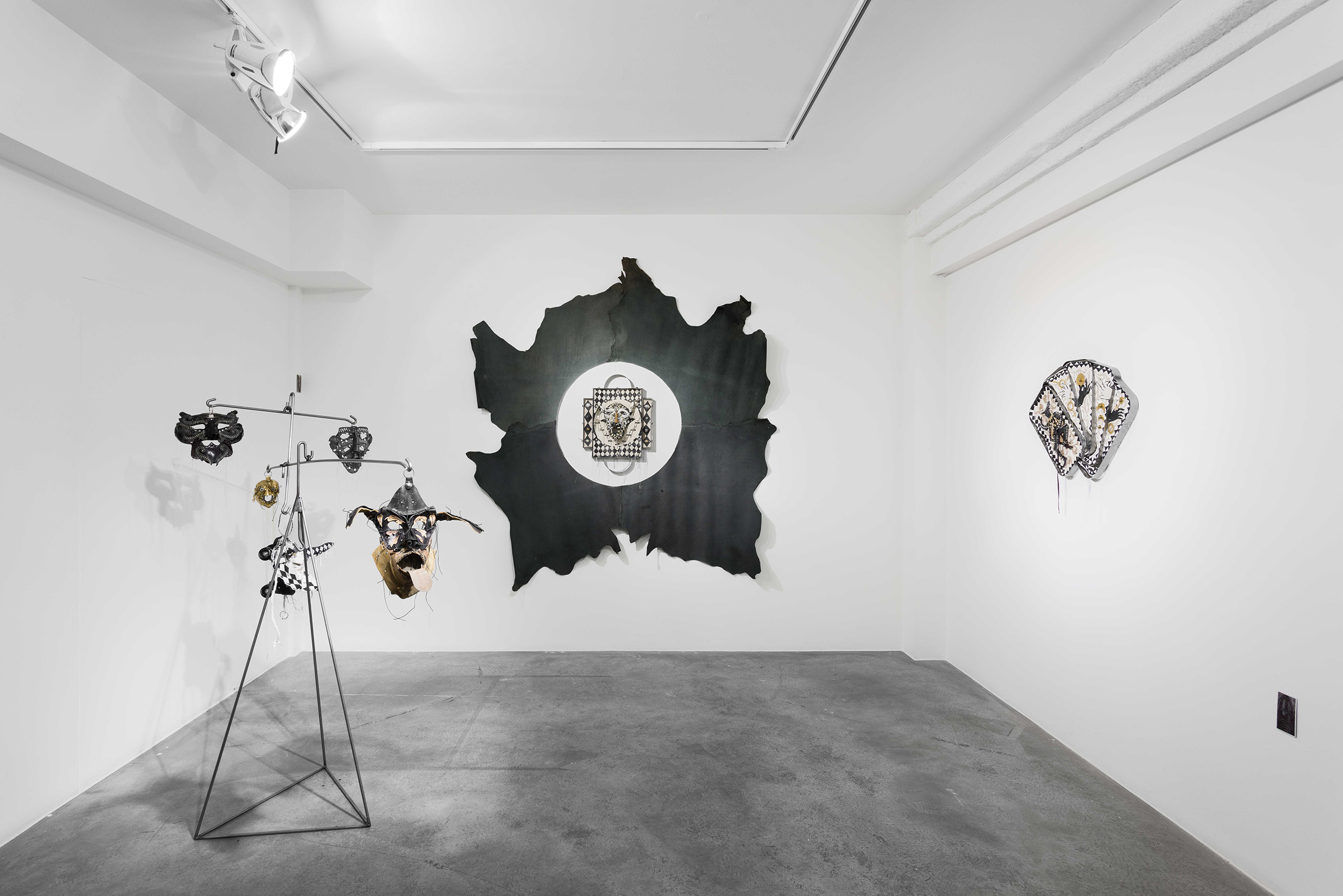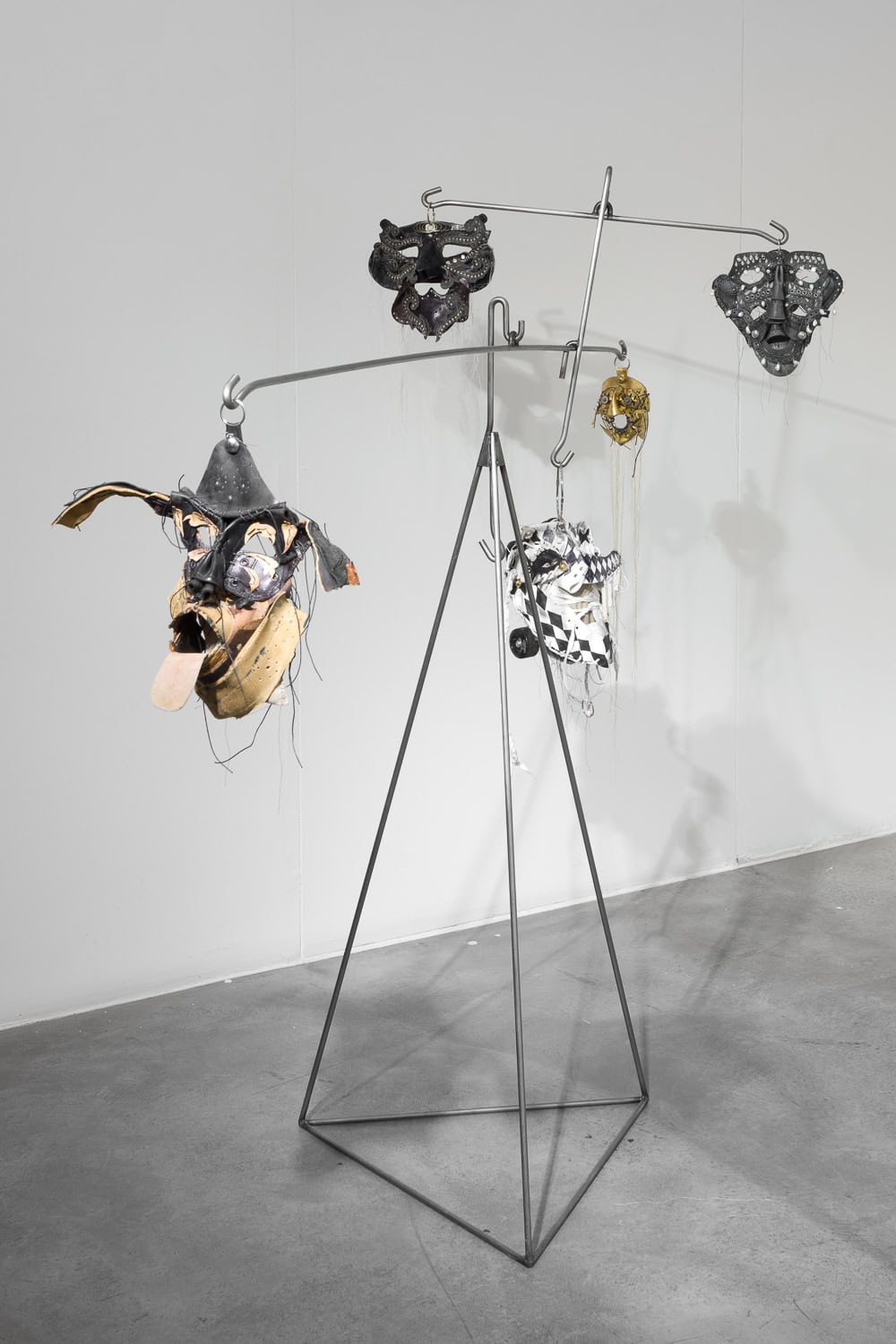
Mask'o'phoria, 2024
This text was commissioned on the occasion of Jakob Rowlinson’s 2024 solo exhibition, Thirteen Fools. The text is written by Hector Campbell, a London-based art historian, writer and curator.
Masquerade, leather faces on parade, Masquerade, hide your face so the world will never find you. Masquerade, every face a different shape, Masquerade, look around, there’s another mask behind you. Masquerade, gaping mouths, studded brows, Masquerade, you can fool anyone who ever knew you. Masquerade, leering satyrs, peering pups, Masquerade, take your fill, let the spectacle astound you. With the exactitude of a seasoned butcher preparing a carcass into its most saleable cuts of meat, Jakob Rowlinson fillets, flays and spatchcocks his selection of reclaimed shoes, carefully unstitched them to expose their pattern-cut leather pieces. Unable and uninterested in disguising their original intention he harvests the hides, embracing the already-established anthropomorphic mimetism of a shoe’s tongue or incorporating original ornate broguing into his own cobbled constructions. Improvisational mask-making from a self-taught seamster, intentionally avoiding perfection and leaning on our innate pareidolia, that oddly empathic tendency to perceive recognisable forms – especially human faces – in otherwise inanimate objects or inane patterns.
For Rowlinson, identity, community and self-comprehension can be found in pre-existing archives, those folkloric, cultural and personal pasts that lie waiting to be re-evaluated and reimagined, from which to co-opt a colourful cast of characters for his mediaeval masquerade melodrama of queer disidentification. Seeking prior precedents in order to retain agency over an increasingly precarious present, and true to an occultist tradition of religious appropriation for a secular satirisation, myths and legends are recontextualised for a 21st-century reading. Removed from any already established hierarchies, both high and low-brow references enrich the artist’s weaved world. Here, the history of hides themselves is exposed, especially the othered experience of a traditional mediaeval tanner, those outcasts forced to live on the odoriferous outskirts, close enough to fetch the collective urine and faeces needed to clean and soften the leather, but far enough away to stop the subsequent smells wafting back across the settlements. Leather, also, is already replete with both conventional and subcultural connotations. Bearded bikers with their matching jackets and chapter patches, cowboys in their buckled boots and riding chaps (‘assless’ an unnecessary tautologous prefix) or heavy metal heads and punk rockers redefining the anarchic aesthetic. Manly men. Real men’s men. Easy homoeroticism borrowed by the leather bar scene in the latter half of the last century, by leathermen and leather daddies previously dissatisfied and unserved by their own queer culture or style.

Thirteen Fools, 2024
So too, the studded collars, hoods and muzzles of pup play meet the human-animal hybridity of the gargoyles, grotesques and hunky punks that sit atop and astride Gothic churches – supposedly to ward off evil spirits whilst simultaneously reminding curious congregants of the distinction between the divine and our earthly delights. An application of gold leaf recalls the gilded green man bosses of the Norwich Cathedral cloisters, heraldry of the artist’s hometown. Those foliate faces invariably denoting rebirth and the rites of spring also act as the vegetal variant of another mythical wilderman, the wood-wose. Covered head to toe in fine hairs – reflected by Rowlinson in his straggly stitching and loose hanging threads – this hirsute figure represents the contemporary condemnation and requisite removal of body hair, as well as the empowered embrace of it as a symbol of gender non-conformity or general disavowal of societal norms or sexual expectations.
Rowlinson’s masks hang head height, rotating tantalisingly, ready to receive the visage of a viewer. Imbued with potential, possibility and the power that comes from momentary masked anonymity. An ob-scuration of identity, illicit and alluring, allowing for the creation of a character or performative persona, a break from quotidian convention and the stagnating self. A certain suspension of disbelief, employing the aesthetics of art and artifice that also underscores much mediaeval folklore and modern magic tricks. Silhouettes, shadow puppets and sleight of hand. That merging or mixing of reality with fantasy in which the queer community are well versed, with ‘passing’ a performative practice of self-preservation. All rendered here in a palette purloined from that of me-diaeval alchemy, colours created or sourced from the distillation and purification of base materials thought to contain certain spiritual qualities. Undefinable, esoteric and ripe for analogous allegory. A purity perfect for depictions of pomp and pageantry, rem-iniscent of the lost polychromy that once coloured the long-bleached remains of classical Greco-Roman sculptures. Alongside, Rowlinson readily employs the motley pattern, that patchwork of coloured dia-monds once used to demarcate a proper, professional, full-time fool. Those consummate court jesters, hired harlequins and life-long jokers whose mottled tab-ards, tunics and unitards distinguished them from the standard social hierarchies. An ultimate othering, and one that at the very least afforded them the freedom of speech necessary to entertain and insult the assembled masses or adoring monarchy.
Pick a card, any card. Attend the feast of fools, that subversive ecclesiastical ritual carried out in ob-servance of the church and yet populated by parody popes, imitation archbishops and caricatured clergy. This fool a subservient or submissive synonym for deferential humility. Embark on your very own fools’ journey, irregardless of the implications of idiocy or supposed stupidity, as life is appreciated as an act of sheer folly that requires a newborn naivety to undertake undaunted
(By Hector Campbell)
